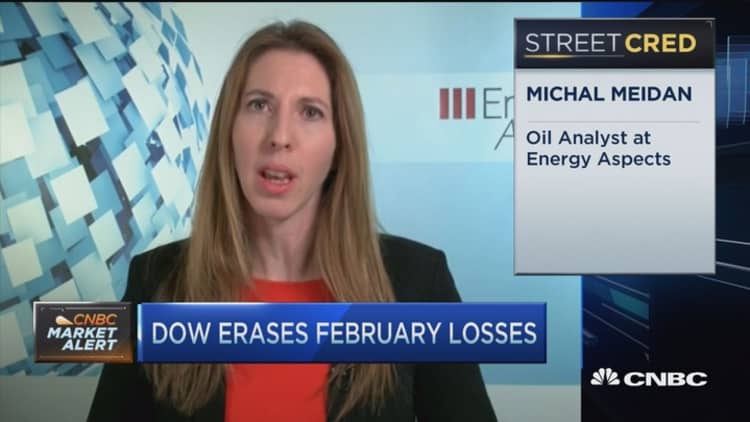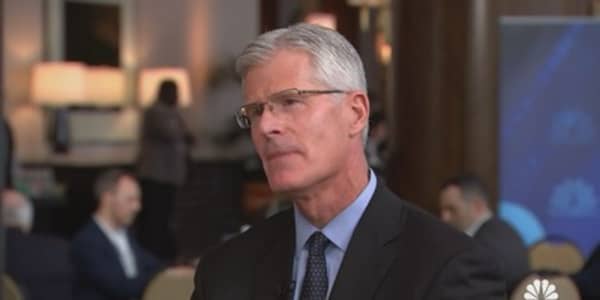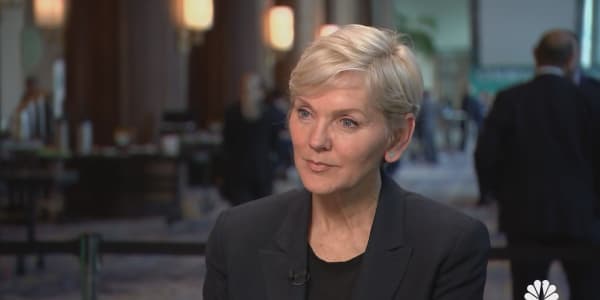When the energy industry gathers in Houston Monday, the big topic will be whether oil prices are actually close to stabilizing after months of painful declines.
The 35th annual IHS CERAWeek conference comes just as the world's largest oil producers — Saudi Arabia and Russia — are talking about ways to support oil prices through a production freeze. While a cap on output will not reduce the world's oil glut, the idea has certainly helped lift crude prices off their lows, but WTI crude was still trading below $30 on Friday afternoon, down near-4 percent.
On Friday, Alexey Texler, Russia's first deputy energy minister, was quoted as saying that the world's excess oil supply could be halved if the freeze takes effect. Qatar and Venezuela joined Saudi Arabia and non-OPEC member Russia in the proposed agreement earlier this week.
The very individuals that could comment on this proposal will be attending the meeting: Saudi Arabian Oil Minister Ali al-Naimi and OPEC Secretary General Abdalla Salem El-Badri. El-Badri speaks Monday afternoon, and Naimi speaks Tuesday morning at 9 a.m. CT.
This is a day of reckoning for oil companies and oil countries.Daniel YerginVice Chairman of IHS
The idea of a production freeze has many proponents, including Daniel Yergin, vice chairman of IHS.
"This is a day of reckoning for oil companies and oil countries, and they need to stabilize the market," Yergin said.
Getting such a deal approved poses challenges since many producers would have to agree to cap production. But there is hope talks could lead to a policy change at the next meeting of the Organization of Petroleum Exporting Countries in June. There has also been speculation members could seek an emergency meeting before then.
"I think the market is beginning to stabilize and perceptions are changing," Yergin said. He noted that there are less negative prognosticators talking about oil prices sinking to $15 to $20 a barrel.
But there is a wild card for the market, and for any producers' deal: Iran. While Iran has said it supports a freeze, there's been no indication it is willing to impose one on its own production. It's in the process of ramping up production with sanctions against its nuclear program being lifted. The idea of more Iranian crude has weighed on the market as traders attempt to gauge just how much oil Iran can actually export. Iran also faces elections at the end of the month, and some analysts say it's unlikely it would agree to hold back on oil sales ahead of that.
At the same time, other forces are at work that will affect the future of the energy industry. "The market is trying to determine whether this is a new era of cooperation between Russia and OPEC," said John Kilduff, partner with Again Capital.
For that reason, industry experts are anxious to hear from the Saudi oil minister Naimi at the event since Saudi Arabia is the driver of OPEC's market-based pricing policy. In an effort to secure its global market share, Saudi Arabia was willing to accept much lower prices.
"Hopefully he'll give us some clarity on what the Saudis' commitment is — freezing production or doing more to stabilize the market," Kilduff said, noting that market watchers wonder if this is just lip service or a game they are trying to play against Iran.
The question of price stability will be an important topic for the global energy industry officials, regulators and political leaders expected to attend IHS CERAWeek.
Mexican President Enrique Peña Nieto speaks Monday, as does Mexican Finance Minister Luis Videgaray Caso. Royal Dutch Shell CEO Ben van Beurden is speaking Tuesday, as does Yilin Wang, chairman of China National Petroleum Corp.
At this time last year, Mexico was playing up plans to bring in outside investment for its natural resource industry.
"The challenge for Mexico is they launched this reform when the mentality was $100 a barrel, and that's not the reality so they've had to have a lot of adjustments. One of the big benefits they're getting is cheap gas from the United States which is helping them bring down electricity costs," Yergin said.
Jose Antonio González Anaya, the new CEO of Pemex, the Mexican energy company, will also attend IHS CERAWeek. Petroleos Mexicanos, or Pemex, has been hit hard by a new round of spending reductions announced this week.
Pemex had a roughly $10 billion third quarter loss, and it has been cutting costs and workers. González Anaya was named CEO earlier this month to turn around the struggling company. He was a former deputy finance minister, and last serviced as director of the Mexican Social Security Institute.
According to Eurasia Group analysts, about $5.4 billion will be cut from Pemex which "will keep Pemex's finances strained and affect Pemex's ability to maintain investment plans." The analysts said Pemex will soon announce its new business plan, and it will try to prioritize the most productive projects and attract investment while cutting costs.
The analysts, in an note, said the Mexican government would also be ready to inject capital into Pemex.

Industry cutbacks
Another big topic at the conference will be how the industry is scaling back, and the tactics it is using to get by on oil prices that have fallen further than most predicted. Last year, the industry was just coming to grips with the idea of lower prices for longer, and now it's been living it.
Yergin said absent a deal among producers to curb production, the industry should have a very difficult first half, but a better second half.
"This year is going to be very rough on the industry, very turbulent. We think that the decline in U.S. production is going to get more serious – another 600,000 to 800,000 barrels a day in this kind of price environment. The U.S. would decline that much by summer, and that starts to set the basis for a greater stabilization," Yergin said.
The U.S. is the world's third-largest oil producer and its rapid arrival on the world scene over the past five years contributed to the roughly 1.5 million to 2 million barrels a day in global oversupply.
Globally, the industry has trimmed upstream oil and gas capital spending in 2015 by nearly 30 percent from the 2014 level, according to IHS CERA data. But North America saw an even steeper cut back, with spending falling 41 percent in 2015.
For 2016, IHS CERA stated that several large North American upstream companies are cutting spending by 50 percent or more compared to 2015 levels.
Companies are also moving beyond capital spending cuts. Ryan Lance, CEO of ConocoPhillips will also participate in the IHS CERAWeek conference and his company, earlier this month, became the first large oil company to cut its dividend.
Wall Street analysts expect other companies to follow with dividend cuts of their own.
"I think we'll hear a lot of debate about how much capacity in the industry will be lost. Can you bring it back when you need it? There is a short-term question of protecting your balance sheet and being in survival mode. There is a question longer term about the resilience of the individual companies and the resilience of the industry. That's going to be on the minds of a lot of people," Yergin said.
Boosting efficiencies
Another "day of reckoning" for the U.S. industry is near as bank reviews of existing debt agreements arrive this spring, and some lenders will surely cut back unless there's a significant turnaround in prices.
But there has been a silver lining for the U.S. industry, which has not seen a dramatic cut back in production yet, and that is higher efficiency. U.S. production peaked at 9.6 million barrels a day, and was reported to be 9.1 million barrels a day last week.
"Under the duress of price and just the learning curve, people continued to get more efficient and by the end of 2015, a dollar spent was about 60 percent more efficient than it was in 2014," Yergin said.
Honeywell is one company that has been working to help drillers become more efficient.
Bruce Calder, vice president and CTO Honeywell Process Solutions, said Honeywell sees lot of opportunity now as producers attempt to lower costs. Honeywell, for instance, has a remote technology specifically designed for the well head. The unit provides workers with data on what's going on and will alert them to whether something is wrong in the well and across the oil field.
"All of this drives down cost. You're using less people. You're getting more production out," Calder said.
Calder said the cost of staffing and equipment across the industry has become very competitively priced. "Technology is probably the biggest play. If you have the right data, you can make the right decision," he said.
Besides the oil industry, natural gas players will be in attendance at IHS CERAWeek, and this could be a historic week for the U.S. gas industry. The Wall Street Journal reports that Cheniere could be sending off the first shipment of LNG for export sometime this week and the buyer was reported to be Petrobras.
Cheniere's Meg Gentle, president of marketing, will be participating on a panel Wednesday morning.





